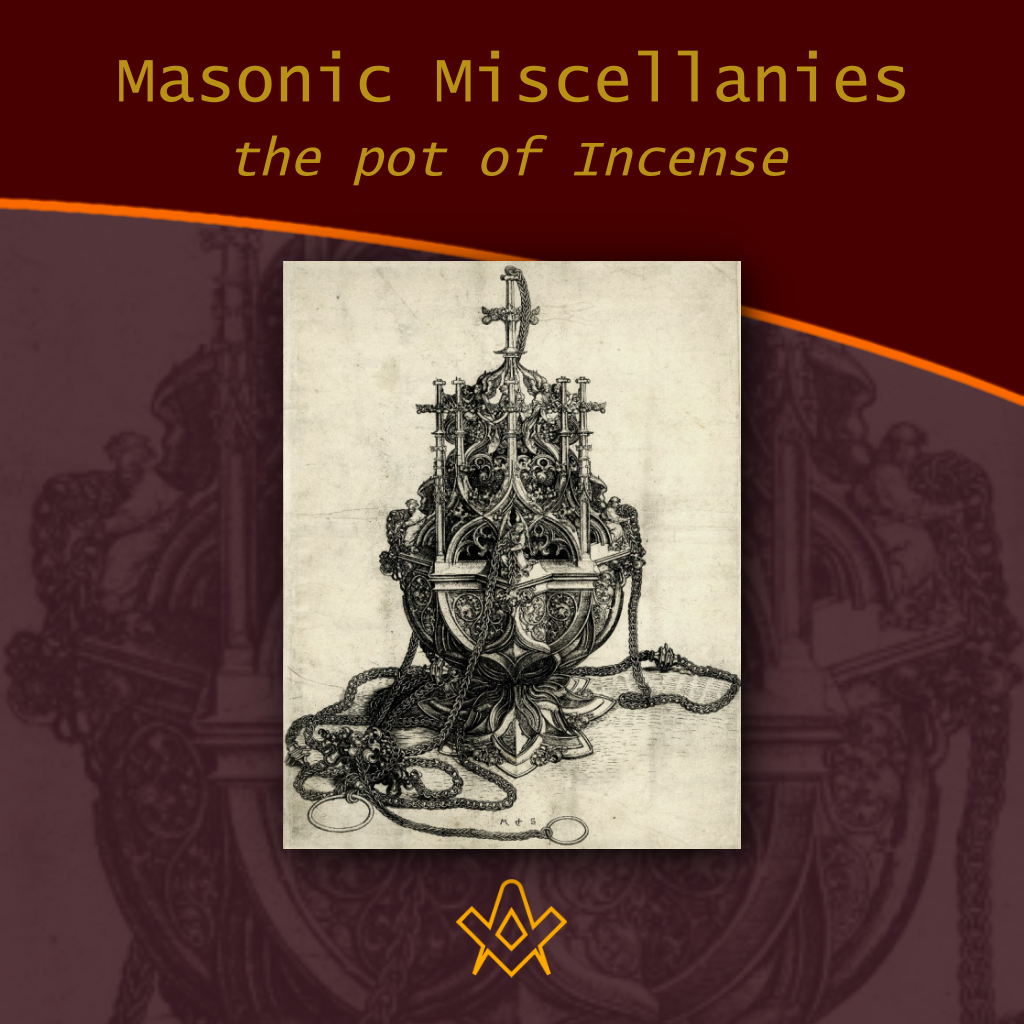“The Pot of Incense is an emblem of a pure heart; this is always an acceptable sacrifice to the Deity; and as this glows with fervent heat, so should our hearts continually glow with gratitude to the great and beneficent author of our existence for the manifold blessings and comforts we enjoy.”
– Thomas Smith Webb
Pot of Incense
SHORT TALK BULLETIN – Vol. XIII May, 1953 No.5
Unknown Author
Just when the pot of incense became an emblem of the third section of the Sublime Degree can not be stated with certainty.
It is, apparently, an American invention or addition; both McKensie and Kenning say that it is not used in the English work.
The Monitor of Thomas Smith Webb, who worked such ingenious and cunning changes in the Prestonian work, gives the commonly accepted wording:
The Pot of Incense is an emblem of a pure heart; this is always an acceptable sacrifice to the Deity; and as this glows with fervent heat, so should our hearts continually glow with gratitude to the great and beneficent author of our existence for the manifold blessings and comforts we enjoy.
Jeremy Cross prints it among the delightfully quaint illustrations in the “True Masonic Chart” – illustrations which were from the not altogether uninspired pencil of one Amos Doolittle, of New Haven.
However the Pot of Incense came into American rituals, it is present in nearly all, and in substantially the same form, both pictorially and monetarily.
If the incense has no great antiquity in the Masonic system, its use dates from the earliest, and clings to it from later, Biblical times, and in Egypt and India it has an even greater antiquity.
In the very early days, as chronicled in the Bible, incense was associated more with idolatry than with true worship; for instance:
Because they have forsaken men and have burned incense unto other Gods, that they might provoke me to anger with all the works of their hands; therefore my wrath shall be poured out upon this place, and shall not be quenched. (II Chronicles, 25-34).
To what purpose cometh there to me incense from Sheba, and the sweet cane from a far country? your burnt offerings are not acceptable, nor your sacrifices sweet unto me. (Jeremiah 6-20).
Moreover I will cause to cease in Moab, saith the Lord, him that offereth in the high places, and him that burneth incense to his Gods. (Jeremiah 35-48).
However, when the worship of JHVH (Which we call Jehova) was thoroughly established, burning incense changed from a heathenish, idolatrous custom to a great respectability and a place in the Holy of Holies. Leviticus 12-16, 13 sounds this keynote:
And he take a censer full of burning coals of fire from off the altar before the Lord, and his hands full of sweet incense beaten small, and bring it within the vail:
And he shall put the incense upon the fire before the Lord, that the cloud of incense may cover the mercy seat that is upon the testimony, that he dieth not.
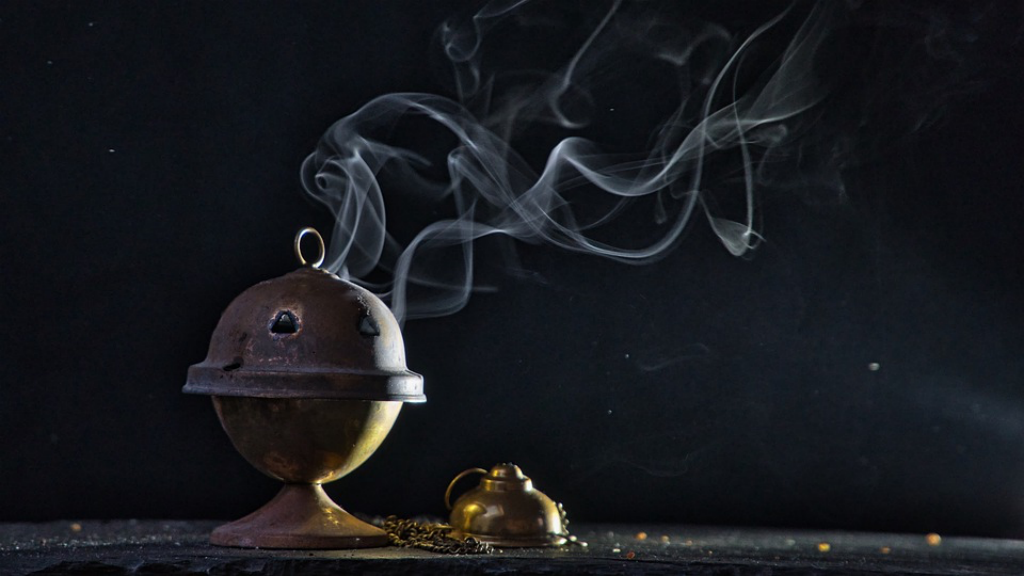
Image by Matthias Grießhammer from Pixabay
Later, incense was associated with wealth and luxurious living, as in the Song of Solomon:
Who is it that cometh out of the wilderness like pillars of smoke, perfumed with myrrh and frankincense, with all the powders of the merchant? (3-6)/ Until the day break, and the shadows flee away, I will get me to the mountain of myrrh, and to the hill of frankincense. (406).
Thy lips, O my spouse, drop as the honeycomb: honey and milk are under thy tongue; and the smell of thy garments is like the smell of Lebanon. Spikenard and saffron; caslamus and cinnamon, with all trees of frankincense; myrrh and aloes, with all the chief spices. (4-14).
In ancient Egypt incense was much used; sculptures and monuments of remote dynasties bear testimony to its popularity.
Many a Pharaoh is depicted with censor in one hand, the other casting into it the oastils or osselets of incense.
In embalming, the Egyptians used all the various gums and spices “except” frankincense, which was set apart and especially consecrated to the worship of the Gods.
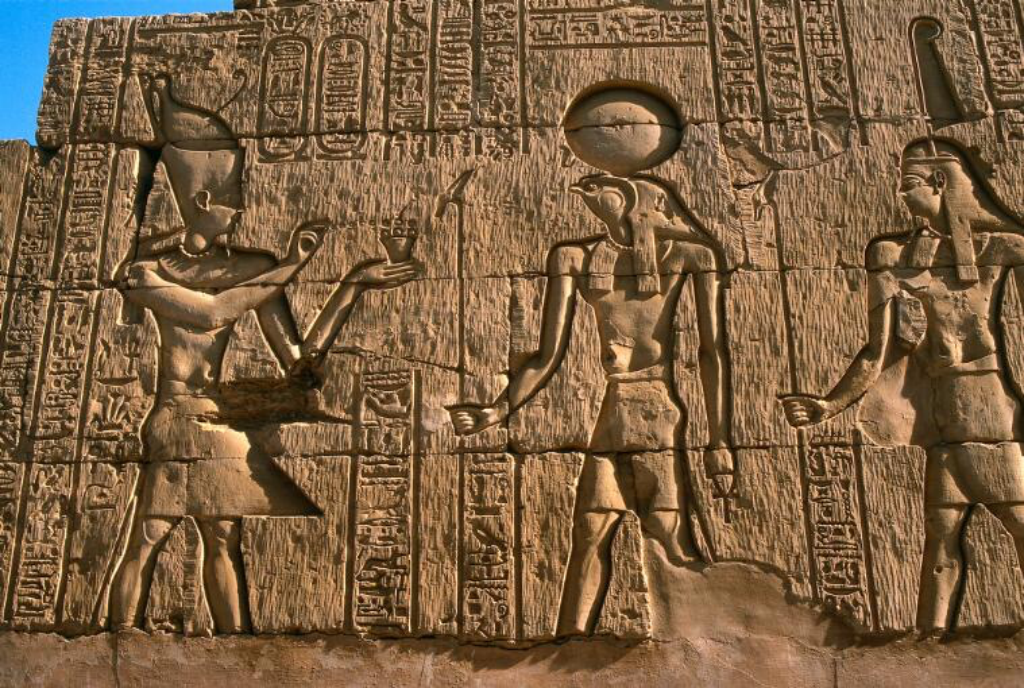
Credit: Ptolemaic pharaoh offering incense to Horus, wall relief.Carole Reeves.Attribution 4.0 International (CC BY 4.0)
In India incense has always been a part of the worship of the thousands of Gods and Goddesses of that strange land. Buddhism has continued its use to this day as a part of the ceremonies of worship – as, indeed, have some Christian churches – and in Nepal, Tibet, Ceylon, Burma, China and Japan it is a commonplace in many temples.
The list of materials which can be incorporated into incense is very long; the incense of the Bible is of more than one variety, there being a distinction between incense and frankincense, although a casual reading of these two terms in many Biblical references makes them seem to be any sacrificial smoke of a pleasant odor.
Ordinarily it was made of various vegetable substances of high pungency; opobalsamun, onycha, galbanum and sometimes pure frankincense also, mixed in equal proportion with some salt.
Frankincense, a rare gum, is often coupled with myrrh as an expensive and therefore highly admiring and complimentary gift; recall the Wise Men before the infant Jesus:
And when they were come into the house, they saw the young child with Mary his Mother, and fell down, and worshipped him: and when they opened their treasures, they presented him gifts; gold, and frankincense, and myrrh.(Matthew 2-11).
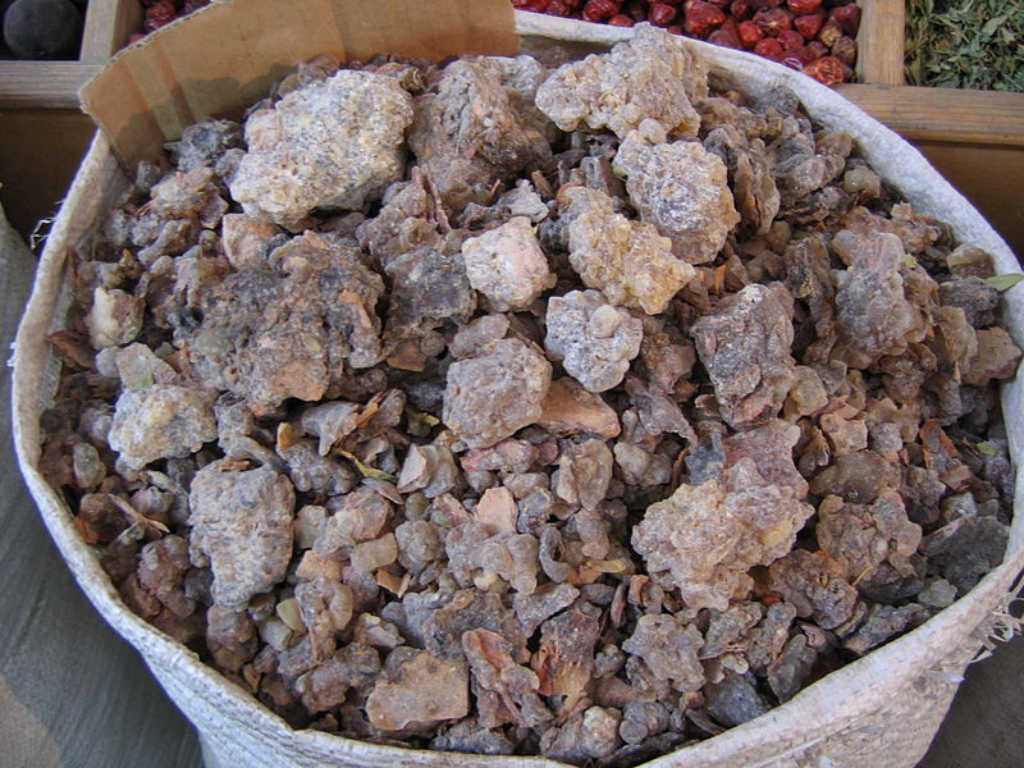
Frankincense sold in a souk. Wikimedia CC BY-SA 2.0
Where or how the use of incense arose, of course is a sealed mystery as far as evidence goes. Modern science, however, enables a reasonable guess to be made.
Of the five senses, smell is the most closely associated with memory and mood. To neither sight nor sound does the emotional part of personality respond as it does to odor.
The scent of certain flowers so surely spells grief to many that they will leave a room in which tube roses or lilies fill the air with scent.
Certain odors are so intimately identified with certain experiences that they become for all time pleasant, or the reverse; few who have smelled ether or iodoform from personal experience in hospitals enjoy these, in themselves not unpleasant smells; any man who has loved outdoor life and camping cannot smell wood smoke without being homesick for the streams and fields; he who made love to his lady in lilac time is always sentimental when he again sniffs that perfume, and the high church votary is uplifted by the smell of incense.
In the ceremonials of ancient Israel doubtless the first use of incense was protections against unpleasant odors associated with the slaughtering of cattle and scorching of flesh in the burnt offering.
At first, but an insurance against discomfort, incense speedily became associated with religious rites. Today men neither kill nor offer flesh at an altar, but only the perfume of “frankincense and myrrh.”
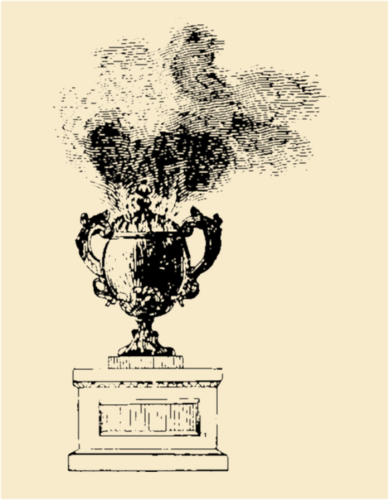
Pot of Incense, ‘True Masonic Chart’, Jeremy Cross, Philadelphia, Moss & co., 1867.
IMAGE LINKED: wikimedia Attribution 4.0 International (CC BY 4.0)
The Masonic pot of incense is intimately associated with prayer, but its symbolic significance is not a Masonic invention.
Psalms 141-2 reads: “Let my prayer be set forth before thee as incense; and the lifting up of my hands as the evening sacrifice.”
Revelations 8-3 reads: “And another angel came and stood at the altar, having a golden censer; and there was given unto him much incense, that he should offer it with the prayers of all saints upon the golden altar which was before the throne.”
The association of a sweet smell in the air, which scattered after it gave pleasure with prayers to an Unseen Presence is easy to understand, even that it arose in primitive minds.
Prayer was offered and rose on high – so its utterers hoped. It was never seen of men. It returned not. Its very giving gave pleasure.
These statements are as true of burning incense as of prayer. What is less obvious, although the ritual is plain enough on the subject, is that it is not only incense, but a “pot” which is the Masonic symbol.
If the sweet savor of incense is like unto a prayer, so is the pot from which it comes like unto the human heart which prays.
Now prayer may come from an impure as well as from a pure heart. But incense is invariably sweet in smell, and so the pot from which it comes is an emblem of a heart pure, sweet and unsullied. Just what “purity” is as applied to a heart is a moot question.
Very unfortunately the word “pure” has been debased – the word is used advisedly – in certain dogmas to mean “ignorant” – as a “pure” young girl; a “pure” woman.
According to this definition a female may be a virago, a cheat, a liar, slander her neighbors, steal, even commit a murder; but, if she is a virgin, she is “pure.”
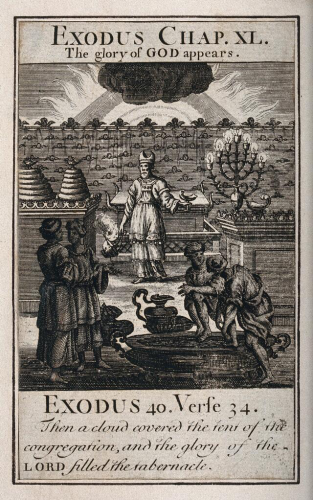
God appears radiantly behind a black cloud as Moses swings an incense burner; four people are washing their feet and hands in preparation. Etching.
IMAGE LINKED: wellcome collection Attribution 4.0 International (CC BY 4.0)
Masonically, the word means nothing of the kind. In 1921, M.W. George H. Dern, Past Grand Master of Utah (Now Secretary of War) contributed some thoughts on “Monitorial Symbolism of the Third Degree and Its Application to Everyday Life” to columns of “The Builder.”
Originally written for the Committee on Masonic Education of the Grand Lodge of Utah, these paragraphs were at once so practical and so pungent that the (then) great Masonic Journal gave them wider circulation.
Quoting the Ritual about the Pot of Incense, M.W. Brother Dern said:
“A sentiment so lofty is not easily applied to the practical, prosaic events of a busy day. To have a pure heart is to be true to yourself, true to your best ideals, and honest with your thoughts. To Thine Own Self Be True. . . Thou Canst Not Then Be False To Any Man.”
Living a life of deceit and double-dealing never made anyone happy. Riches or pleasures acquired in that way bring only remorse, and eventually the soul cries out in anguish for that peace of mind which is man’s most precious possession, and which is the companion of a pure heart.
“Purity of heart means conscientiousness, and that means sincerity. Without sincerity there can be no real character. But sincerity alone is not enough.
There must go with it a proper degree of intelligence and love of one’s fellows. For example, a man may believe that the emotion of pity and the desire to relieve the necessities of others is intrinsically noble and elevating, and he indulges in indiscriminate giving, without realizing the evil consequences, in the way of fraud, laziness and inefficiency and habitual dependence that his ill considered acts produce upon those whom he intends to benefit.
Again, a man may be perfectly sincere in talking about the shortcomings of another, and he may justify himself by saying that he is telling nothing but the truth.
But, merely because they are true is no reason why unpleasant and harmful things should be told. To destroy a reputation is no way to aid a brother who has erred. Better far overlook his mistakes, and extend him a helping hand.
“Without multiplying examples, let it be understood that the truly conscientious man must not simply be sincere, but he must have high ideals and standards, and moreover, he must not be satisfied with those standards.
Rather he must revise them from time to time, and that means self-examination, to see if he possesses the love and courage that must go with sincerity in order to make progress in building character.
For in this direction again there must be constant progress. To be content with what we have accomplished is fatal.
As James A. Garfield once said, “I must do something to keep my thoughts fresh and growing.
I dread nothing so much as falling into a rut and feeling myself becoming a fossil.” Many words in the ritual have changed meanings since they were first used.
The Masonic term “profane,” for instance, originally meant “without the temple” – one not initiated, not of the craft.
Today it means blasphemous, which is no part of the Masonic definition of the word. “Sacrifice” in our Monitor seems to come under this classification.
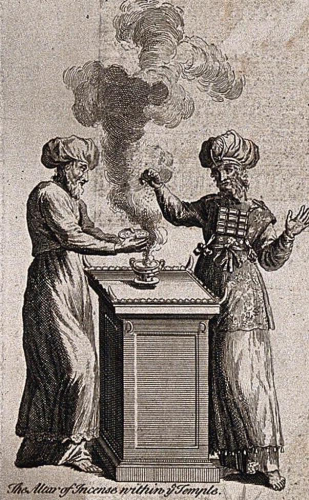
The Altar of Incense. Detail from ‘The Temple of Solomon, its grounds and some of its interiors’. Engraving.
IMAGE LINKED: wellcome collection Attribution 4.0 International (CC BY 4.0)
In the Old Testament, a sacrifice before the altar was the offering of something – burned flesh, burning incense, pure oil or wine – which involved the sacrificer giving something valuable to him; the sacrifice was an evidence before all men that the sacrificer valued his kinship with the Most High more than his possession of that which he offered.
In our ritual the word has lost this significance. The pot of incense as an emblem of a pure heart “which is always an acceptable sacrifice to the Deity” can hardly connote the idea that a Mason desires to keep his “pure heart” for himself, but because of love of God is willing to give it up. Rather does it denote that he who gives up worldly pleasures, mundane ideas and selfish cravings which may interfere with “purity of life and conduct” as set forth in other parts of the ritual, does that which is acceptable to the Great Architect.
Masonically, “pure” seems to mean honest, sincere, genuine, real, without pretense and “sacrifice” to denote that which is pleasing to the most high.
So read, the Masonic pot of incense becomes an integral part of the philosophy of Freemasonry, and not a mere moral interjection in the emblems of the third degree.
For all of the magnificent body of teaching which is self revealed, half concealed in the symbolism of Freemasonry, nothing stands out more plainly, or calls with a louder voice, than her insistence on these simple yet profound virtues of the human heart lumped together in one phrase as “a man of higher character” . . .in other words, one with a “pure heart,” “pure” meaning undefiled by the faults and frailties of so many of the children of men.
Recent Articles: Masonic Miscellanies
 Masonic Miscellanies - The Amulet of the Ladder Explore the cosmic significance of the Ladder in ancient Egyptian mythology through Wallis Budge's "Egyptian Magic." Discover how this profound symbol bridges the mortal and divine, encapsulating the Egyptians' fervent afterlife aspirations with a blend of myth, magic, and material culture. Dive into the celestial ascent of Osiris and mortal souls. |
 Masonic Miscellanies - Adulterine Gilds Guilds, the associations that shaped medieval European society, were more than just organizations of artisans and merchants. They played a vital role in the economic and social development of towns and cities. This exploration delves into the intriguing concept of adulterine gilds and their interconnectedness with guilds, offering insight into the significance of legal authorization and recognition in medieval Europe. |
 Masonic Miscellanies - Masonic Orb Discover the fascinating world of Masonic ball watch fobs, intricately crafted with tiny pyramids that form a cross when opened. These decorative accessories were all the rage in the late 1800s and early 1900s, and they still hold a certain allure today. Explore the different varieties and symbols found on these unique pieces that carry deep Masonic meaning. |
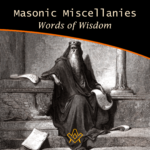 Masonic Miscellanies – Words of Wisdom Uncover timeless wisdom from King Solomon to Albert Pike in our latest Masonic Miscellanies, a treasure trove of insights for Masons. Journey through the ages and glean inspiring sayings, reflecting on their profound influence on Masonic principles. An enriching read for the enlightened. |
 Masonic Miscellanies - Symbolism of the Right Hand Unlock the enigmatic realm of Freemasonry as we delve into its age-old symbols, rituals, and philosophies. This thought-provoking exploration, drawn from Mackey's Revised Encyclopedia of Freemasonry, focuses on the iconic 'right hand' symbol - its rich history, universality, and profound significance. |
 Masonic Miscellanies - Order of the Secret Monitor Unveil the mystery of Freemasonry with 'The Order of the Secret Monitor'. Discover this lesser-known appendant order, its unique rituals, and the profound teachings it offers. Explore the bonds of friendship and brotherhood it fosters, all wrapped in an intriguing cloak of mystery. Your journey into the depths of Masonic wisdom begins here. |
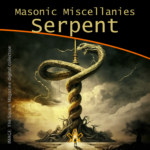 Masonic Miscellanies - The Symbol of the Serpent As a symbol, the serpent obtained a prominent place in all the ancient initiations and religions. |
 Masonic Miscellanies - The Four Veils in Royal Arch Masonry What are the four veils in Royal Arch Masonry? And what is the 'Ceremony of Passing the Veils'? Although common throughout Scotland, Ireland and the United States, it is mostly unknown in England, presently only worked in the Province of Bristol. ( and by dispensation ) |
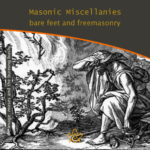 Masonic Miscellanies - Bare feet and Freemasonry A candidate for initiation into a Masonic Lodge often finds the requirements which he/she must fulfil somewhat odd. The mode of preparation often remains a puzzle, since the ritualistic explanation is not offered in full. Why are we 'slipshod' or "bare-footed" in Masonic Ritual? |
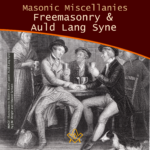 Masonic Miscellanies – Freemasonry and Auld Lang Syne Millions of people throughout the world will sing Auld Lang Syne to see out the Old Year. Few will know all the words, fewer still know what they mean, or that there is a link to Freemasonry. |
 Masonic Miscellanies - The Mosaic Pavement - why mosaic, why pavement? We are all familiar with the black and white chequered flooring of the Masonic lodge but where did it originate? There are a few theories… |
 Masonic Miscellanies – Masonic Master's Carpets Have you got a magic "Masonic Master's Carpet" in your lodge? I say 'magic' with my tongue firmly in my cheek because (as far as I know) these fabulous works of art don't bestow any mystical powers but can bestow some educational ones! However, considering their possible value today, they may magic up some interest (or funds). |
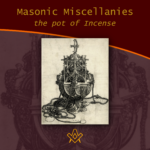 Masonic Miscellanies – The Pot of Incense Just when the pot of incense became an emblem of the third section of the Sublime Degree can not be stated with certainty. It is, apparently, an American invention or addition. But what does it symbolise? |
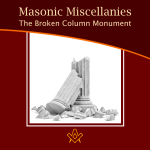 Masonic Miscellanies - The Broken Column Monument The story of the broken column was first illustrated by Amos Doolittle in the "True Masonic Chart" by Jeremy Cross, published in 1819. |
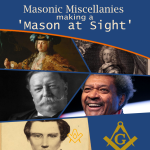 Masonic Miscellanies - Making a 'Mason at Sight' What does it mean to make a 'Mason at sight', and who was made one? |
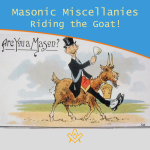 Masonic Miscellanies - Riding the Goat! Many Freemasons will have come across the phrase 'riding the goat', and will no doubt have been the butt of a joke about it (sorry, I couldn't resist!) But what does it mean and where did the phrase come from? |
 Masonic Miscellanies - What are the 'three dots'? Three dots or points in an upright triangular shape ∴ is most commonly known as the 'therefore' sign – so why is it used in Freemasonry? |
 Masonic Miscellanies - Keep Within Compass This month we discover a series of allegorical prints warning us to "Keep within Compass and you shall be sure, to avoid many troubles which others endure." |
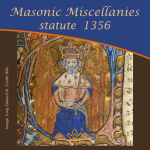 Masonic Miscellanies - statute 1356 Further to the reference in the article – The Builders - 6 - Free-Masons 'a statute was enacted against the Free-masons in 1356' – Regulations for masons who are hewers, on the one hand, and the light masons and setters on the other. |
 Masonic Miscellanies - An Anti-Masonic 'Apron'? The Anti-Masonic 'Apron' was created during the 1832 Presidential election in USA. It was not Ani-masonic. And it was not an apron. Read on to find out what and why it was created. |
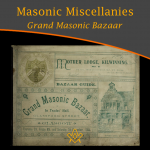 Masonic Miscellanies - Grand Masonic Bazaar (1895) Grand Masonic Bazaar (1895); to raise funds to clear the debt incurred by “Mother Kilwinning” in rebuilding their Lodge. |
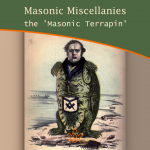 Masonic Miscellanies - the 'Masonic Terrapin' A satirical book from 1851 includes a bizarre caricature of a 'Masonic Terrapin' - all I can say is 'read on'… |
 Masonic Miscellanies - Masonic Bookplates You probably know what a bookplate is for, but did you know that the earliest known book mark/label dates from the reign of Amenhotep III in Egypt around 1391−1353 BCE?! |
 Masonic Miscellanies - Freemasonry & Bees Freemasonry & Bees - what's the buzz? The bee was among the Egyptians the symbol of an obedient people, because, says Horapollo, of all insects, the bee alone had a king. |
 Masonic Miscellanies - The mystery of the Tattooed Freemason In 1894, the body of a drowned man was found in the Bay of San Francisco - what they discovered was amazing. |
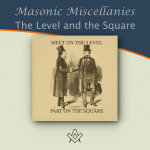 Masonic Miscellanies - The Level and the Square (A Poem) The Level and the Square (A Poem) - "We meet upon the Level, and we part upon the Square – |
 Masonic Miscellanies - The Mystic Tie What is the 'Mystic Tie'? Clue: it's not an item of neckwear! |
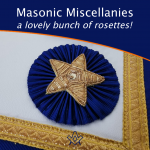 Masonic Miscellanies - A lovely bunch of rosettes! Where did the origin of the use of rosettes on Masonic aprons come from ? |
 Masonic Miscellanies - The Lodge of Sorrow The Lodge of Sorrow - Extracted General Ahiman Rezon, by Daniel Sickles, [1868] |
 Masonic Miscellanies - Memento Mori Memento Mori - a Masonic reminder to make your mark on the world |
 Masonic Miscellanies - A closer look at the Level and the Plumb-rule A closer look at the Level and the Plumb-rule |
 Masonic Miscellanies - The Symbolism of the Gloves The Symbolism of the Gloves and why Freemasons wear white gloves |
 Masonic Miscellanies - Will the real James Anderson please stand up? Will the real James Anderson please stand up? |
 Masonic Miscellanies - The Legend of the Third Degree The most important and significant of the legendary symbols of Freemasonry is, undoubtedly, that which relates to the fate of Hiram Abif. |
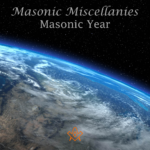 Masonic Miscellanies - Masonic Calendar Why do Freemasons use different 'years' to our regular calendar? |
 Masonic Miscellanies - What is a 'Lewis'? The English word 'Lewis' is a term belonging to operative Masonry, and signifies an iron cramp, which is inserted in a cavity prepared for the purpose in a large stone. |
 Masonic Miscellanies - From J.S.M. Ward Ever wondered why masons had to be 'free' or why we have a Tyler? |
masonic knowledge
to be a better citizen of the world
share the square with two brothers

click image to open email app on mobile device



